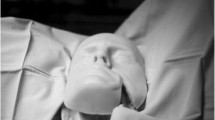Abstract
Background
Major vessel injury (MVI) is a dangerous complication associated with laparoscopic surgery that leads, if not properly handled, to blood loss, conversion to open surgery, and eventually death. In this paper, we describe the preliminary evaluation of the SimPORTAL MVI model, created with the goal of simulating an intra-corporeal injury to a large vessel.
Methods
For this study, we created MVI models for 17 residents (PGY 1–4). Each resident was asked to perform an intracorporeal knot on a penrose drain within a maximum time limit of 6 min (in accordance with European basic laparoscopic urological skills rules) and then to subsequently repair a vessel injury on the MVI model, which was perfused with synthetic blood, within a maximum blood loss of 3 L. During the vessel repair, low lights and pulse sounds were used to simulate the operating room environment. All participants filled out a survey pre- and post-task to score various aspects of the model.
Results
We successfully created a model that simulates a critical surgical event. None of the participants reported having previous experience repairing a MVI. Six participants were able to perform the intracorporeal knot, and 12 residents (70.5 %) were able to repair the MVI model under the given time and blood loss limits. Eleven participants agreed that the MVI model behaves like a real vessel, and six felt to be capable of performing the task prior to attempting it. Sixteen participants thought that the MVI model should be part of laparoscopic curriculums during residency.
Conclusions
The SimPORTAL MVI model is a feasible low-cost model that would be well appreciated as a part of laparoscopic curriculum for residents. Minor improvements, including pressure measurement in the vessel for task assessment, will be made in the future, and further studies are necessary to definitively validate this model.



Similar content being viewed by others
References
Ghavamian R (2010) Complications of laparoscopic and robotic urologic surgery. Springer, New York
Pareek G, Hedican SP, Gee JR, Bruskewitz RC, Nakada SY (2006) Meta-analysis of the complications of laparoscopic renal surgery: comparison of procedures and techniques. J Urol 175:1208–1213
Kaushik R (2010) Bleeding complications in laparoscopic cholecystectomy: incidence, mechanisms, prevention and management. J Minim Access Surg 6:59–65
Jafari MD, Pigazzi A (2013) Techniques for laparoscopic repair of major intraoperative vascular injury: case reports and review of literature. Surg End 27(8):3021–3027
Xu H, Chen Y, Li Y, Zhang Q, Wang D, Liang Z (2007) Complications of laparoscopic radical hysterectomy and lymphadenectomy for invasive cervical cancer: experience based on 317 procedures. Surg End 21(6):960–964
Sweet RM, Beach R, Sainfort F, Gupta P, Reihsen T, Poniatowski LH, McDougall EM (2012) Introduction and validation of the American Urological Association basic laparoscopic urologic surgery skills curriculum. J Endourol 26:190–196
Brinkman WM, Tjiam IM, Schout BM, Muijtjens AM, Van Cleynenbreugel B, Koldewijn EL, Witjes JA (2014) Results of the European basic laparoscopic urological skills examination. Eur Urol 65(2):490–496
Rassweiler J, Klein J, Teber D, Schulze M, Frede T (2007) Mechanical simulators for training for laparoscopic surgery in urology. J Endourol 21(3):252–262
Klein J, Teber D, Frede T, Stock C, Hruza M, Gözen A, Seemann O, Schulze M, Rassweiler J (2013) Development, validation and operating room-transfer of a six-step laparoscopic training program for the vesicourethral anastomosis. J Endourol 27(3):349–354. doi:10.1089/end.2012.0209
Poniatowski LH, Wolf JS Jr, Nakada SY, Reihsen TE, Sainfort F, Sweet RM (2014) Validity and acceptability of a high-fidelity physical simulation model for training of laparoscopic pyeloplasty. J Endourol 28(4):393–398. doi:10.1089/end.2013.0678 Epub 2014 Jan 16
Collins S, Lehman DS, McDougall EM, Clayman RV Landman J AUA BLUS handbook chapter 10: complications of laparoscopic surgery. American Urological Association, Linthicum (Maryland), pp 81–86. https://www.schulich.uwo.ca/surgery/urology/aua-handbook-of-laparoscopic-roboticfundamentals/files/AUA/AUA%20Handbook%20of%20Laparoscopic%20-%20Robotic%20Fundamentals.pdf
Castle EP, Nunez-Nateras R, Woods ME, Andrews PE (2011) Robotics in genitourinary surgery, chapter 49. Springer, London, pp 553–567
Mansour AM, Peabody JO, Guru KA (2010) Complications of laparoscopic and robotic urologic surgery. Springer, New York, pp 233–245
Peters JH, Fried GM, Swanstrom LL, Soper NJ, Sillin LF, Schirmer B, Hoffman K, SAGES FLS Committee (2004) Development and validation of a comprehensive program of education and assessment of the basic fundamentals of laparoscopic surgery. Surgery. 135(1):21–27
Healey MA, Shackford SR, Osler TM, Rogers FB, Burns E (2002) Complications in surgical patients. Arch Surg 137:611–618
Acknowledgments
SimPORTAL thanks the European Urology Residents Education Programme (EUREP) and the Society of Laparoendoscopic Surgeons (SLS) for helping to facilitate the model reliability tests. Thank you to Jason Speich, Jonathan Chaika, and Jayme Lee for assistance in model building.
Disclosures
Drs. D. Veneziano, L. H. Poniatowski, R. M. Sweet, and T. Reihsen have no conflicts of interest or financial ties to disclose.
Author information
Authors and Affiliations
Corresponding author
Rights and permissions
About this article
Cite this article
Veneziano, D., Poniatowski, L.H., Reihsen, T.E. et al. Preliminary evaluation of the SimPORTAL major vessel injury (MVI) repair model. Surg Endosc 30, 1405–1412 (2016). https://doi.org/10.1007/s00464-015-4344-1
Received:
Accepted:
Published:
Issue Date:
DOI: https://doi.org/10.1007/s00464-015-4344-1




